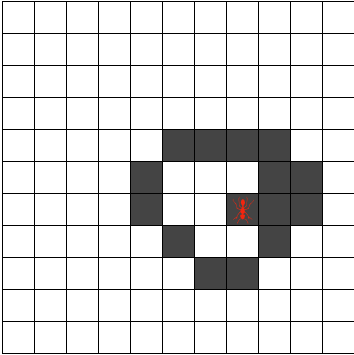历届试题 兰顿蚂蚁
http://lx.lanqiao.org/problem.page?gpid=T125
历届试题 兰顿蚂蚁
时间限制:1.0s 内存限制:256.0MB
问题描述

兰顿蚂蚁,是于1986年,由克里斯·兰顿提出来的,属于细胞自动机的一种。
平面上的正方形格子被填上黑色或白色。在其中一格正方形内有一只“蚂蚁”。
蚂蚁的头部朝向为:上下左右其中一方。
蚂蚁的移动规则十分简单:
若蚂蚁在黑格,右转90度,将该格改为白格,并向前移一格;
若蚂蚁在白格,左转90度,将该格改为黑格,并向前移一格。
规则虽然简单,蚂蚁的行为却十分复杂。刚刚开始时留下的路线都会有接近对称,像是会重复,但不论起始状态如何,蚂蚁经过漫长的混乱活动后,会开辟出一条规则的“高速公路”。
蚂蚁的路线是很难事先预测的。
你的任务是根据初始状态,用计算机模拟兰顿蚂蚁在第n步行走后所处的位置。
输入格式
输入数据的第一行是 m n 两个整数(3 < m, n < 100),表示正方形格子的行数和列数。
接下来是 m 行数据。
每行数据为 n 个被空格分开的数字。0 表示白格,1 表示黑格。
接下来是一行数据:x y s k, 其中x y为整数,表示蚂蚁所在行号和列号(行号从上到下增长,列号从左到右增长,都是从0开始编号)。s 是一个大写字母,表示蚂蚁头的朝向,我们约定:上下左右分别用:UDLR表示。k 表示蚂蚁走的步数。
接下来是 m 行数据。
每行数据为 n 个被空格分开的数字。0 表示白格,1 表示黑格。
接下来是一行数据:x y s k, 其中x y为整数,表示蚂蚁所在行号和列号(行号从上到下增长,列号从左到右增长,都是从0开始编号)。s 是一个大写字母,表示蚂蚁头的朝向,我们约定:上下左右分别用:UDLR表示。k 表示蚂蚁走的步数。
输出格式
输出数据为两个空格分开的整数 p q, 分别表示蚂蚁在k步后,所处格子的行号和列号。
样例输入
5 6
0 0 0 0 0 0
0 0 0 0 0 0
0 0 1 0 0 0
0 0 0 0 0 0
0 0 0 0 0 0
2 3 L 5
0 0 0 0 0 0
0 0 0 0 0 0
0 0 1 0 0 0
0 0 0 0 0 0
0 0 0 0 0 0
2 3 L 5
样例输出
1 3
样例输入
3 3
0 0 0
1 1 1
1 1 1
1 1 U 6
0 0 0
1 1 1
1 1 1
1 1 U 6
样例输出
0 0
分析:
直接模拟路径,和蚂蚁的坐标。
AC代码:

1 #include <stdio.h> 2 #include <algorithm> 3 #include <iostream> 4 #include <string.h> 5 #include <string> 6 #include <math.h> 7 #include <stdlib.h> 8 #include <queue> 9 #include <stack> 10 #include <set> 11 #include <map> 12 #include <list> 13 #include <iomanip> 14 #include <vector> 15 #pragma comment(linker, "/STACK:1024000000,1024000000") 16 #pragma warning(disable:4786) 17 18 using namespace std; 19 20 const int INF = 0x3f3f3f3f; 21 const int Max = 10000 + 10; 22 const double eps = 1e-8; 23 const double PI = acos(-1.0); 24 int a[110][110]; 25 26 void run(int x , int y , char str , int k) 27 { 28 if(k == 0) 29 printf("%d %d\n", x , y); 30 else 31 { 32 k --; 33 if(a[x][y] == 0) 34 { 35 a[x][y] = 1; 36 if(str == 'U') 37 run(x , y - 1 , 'L' , k); 38 else if(str == 'D') 39 run(x , y + 1 , 'R' , k); 40 else if(str == 'L') 41 run(x + 1, y , 'D' , k); 42 else 43 run(x - 1 , y , 'U' , k); 44 } 45 else 46 { 47 a[x][y] = 0; 48 if(str == 'U') 49 run(x , y + 1 , 'R' , k); 50 else if(str == 'D') 51 run(x , y - 1 , 'L' , k); 52 else if(str == 'L') 53 run(x - 1, y , 'U' , k); 54 else 55 run(x + 1 , y , 'D' , k); 56 } 57 } 58 } 59 60 int main() 61 { 62 int i , j , n , m , x , y , k; 63 char s; 64 scanf("%d%d",&n,&m); 65 for(i = 0;i < n;i ++) 66 for(j = 0;j < m;j ++) 67 scanf("%d",&a[i][j]); 68 scanf("%d %d %c %d", &x , &y , &s , &k); 69 run(x , y , s , k); 70 return 0; 71 }
